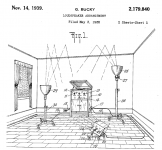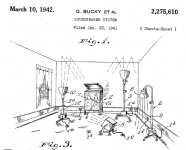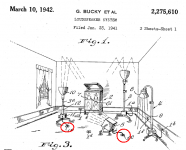None of those links describe the frequency range of the floor reflection that affects the distance perception.
perhaps it is just the same range that generally affects spatial perception - 0.4<4.0 kHz
we don't know of course
but until we know I can't see any reason to exclude the lower midrange a priori
perhaps it is just the same range that generally affects spatial perception - 0.4<4.0 kHz
we don't know of course
That is your assumption. I assume it happens above 1kHz 🙂
That is your assumption. I assume it happens above 1kHz 🙂
that's ok 🙂 let's call it hypothesis
I gave a foundation for my hypothesis - about 0.6 ms/20 cm, You remember?
So please give any for Yours 🙂
Last edited:
Without any added data I only see a subjective description (can't be anything else). I don't dare to take any conclusions from that (and wouldn't call it "results" either).I am trying to understand the results of Elias' test
I would support your argumentation 🙂it is clear that with 400Hz low pass and also 700 Hz low pass the shifting effect is not that severe - perhaps because ....
just a hypothesis
Are You sure?
Isn't it that for a reflection of a wave to occur the reflecting surface must be no closer than a quarter of a wavelength from a sound source?
What you are describing is a resonant condition - and usually that doesn't happen for a discreet freq.. Now increase that to a pass-band and yes, there could be a *reflective* interference that would change intensity somewhere along the pass-band. An extreme example of this would be an un-damped transmission line (with "peaks" and "depressions" in intensity along the pass-band).
but a standing wave between two walls happens at a discreet frequency, doesn't it? And it is simply a reflective condition not just "a *reflective*" 🙂What you are describing is a resonant condition - and usually that doesn't happen for a discreet freq.
Obviously one is missing, no floor, no ceiling pads. silly me. 😡
I see 🙂 So without any absorption the first reflection is something like -3dB ?
but a standing wave between two walls happens at a discreet frequency, doesn't it? And it is simply a reflective condition not just "a *reflective*" 🙂
Typically not - and least not in relation to a discreet freq.. (..most conditions are simply to complex. That's not to say that there might not be some interference to that wavelength - but that's a bit beyond my interest.)
The point is that it's not really a Reflection.
In any event, we a getting a bit "far a-field" here. 😉
Getting back to a timing que from a more empirical perspective - lets look at the condition for an echo, and derivatives from there..
An echo is a reflection, and an apparent one at that (..in other words a reflection that can be described as a separate source of sound). With that in mind, is a lower freq. echo more easily located at the earliest point (distance/time) that it becomes an echo/(apparent) - or at some multiple of that distance/time?
Now consider a low freq. reflection that doesn't have the distance/time to become an echo (or apparent). Under this condition we have the precedence effect - the direct sound dominates and you get a single localized cue. Of course IF the reflection is sufficiently intense you'll get an alteration to that localization effectively moving the source location a bit closer to the point of the reflection. (..note: this can and does happen in rooms at freq.s below 400 Hz - even in a stereo reproduction context: ex. "pushing" images forward like drum-kits and foreshortening depth as the rear of the loudspeaker gets closer to the "front" wall.) With this in mind, will a closer low freq. reflection have more or less effect on a source's position?
With respect to distance/time and reflections - are the results similar?
Finally lets look at simply the onset of a lower freq.. (or a minute portion of that wavelength). Let's disregard the nature of a reflection vs. that of a resonance. Further, let's disregard the primary condition of the precedence effect.
Just looking at distance/time for our onset to a particular lower freq. wavelength, and factoring-in answers to the questions above, will a really near distance/time reflective condition to our wavelength have much effect?
(..Note: I'm not saying/suggesting the onset of the direct sound doesn't have effect, but rather will a very near distance/time reflective condition to that onset have a substantial effect?)
Last edited:
I'm not saying/suggesting the onset of the direct sound doesn't have effect, but rather will a very near distance/time reflective condition to that onset have a substantial effect?
most probably not - not substantial - but also most probably highly depending on the program material
and I ask why not
because only if we know why we can say when it can happen and only the we can consciously take it into account in the loudspeaker design
I see 🙂 So without any absorption the first reflection is something like -3dB ?
maybe? I would need to redo a set of measurements without the pads, and without the thick carpet..
without toe in the side reflexion is at 0db! 😱
one thing really bothers me, the signal is not clean at all in the first 1ms.
To me it is as clean as it gets in the first ms. All ETCs I know have widened somewhat at -15 dB.one thing really bothers me, the signal is not clean at all in the first 1ms.
But then after three years something went terrible wrong, since he concluded the sound of the ceiling firing flooders is coming from the floor !! 😱
??? wtf???


 😕
😕??? wtf???

😕
Things aint hilarious if you need to explain them 😡
"... the sound is coming from the floor ..."
Attachments
Things aint hilarious if you need to explain them 😡
"... the sound is coming from the floor ..."
I can see that some wires are "coming from the floor"... but what about the sound??? ...er... "hillarious 😡"??? Am I to understand that You don´t like good humour in audio? 🙂
most probably not - not substantial - but also most probably highly depending on the program material
and I ask why not
because only if we know why we can say when it can happen and only the we can consciously take it into account in the loudspeaker design
-assuming a "fast" transient in the freq. range.
Even then - almost certainly doubtful.
Why? Because as the timing cue lowers for any reflective condition it becomes increasingly inaudible (all else equal). A near-time actual reflection with that same "fast" transient in the freq. range - doesn't alter the presentation in an audible fashion, what suggestion is there that an even more time-abbreviated reflective condition would? NONE.
Along with the timing aspect of the direct sound onset, you can have resonant artifacts with most program material (i.e. "broad-band") - but there the focus is on the corruption of the signal with respect to intensity, not time.
BTW, I don't mind questioning this - but I don't have *any* reason to believe any differently from what I've just stated. Prove me wrong. 😉
- Home
- Loudspeakers
- Multi-Way
- The Advantages of Floor Coupled Up-Firing Speakers


